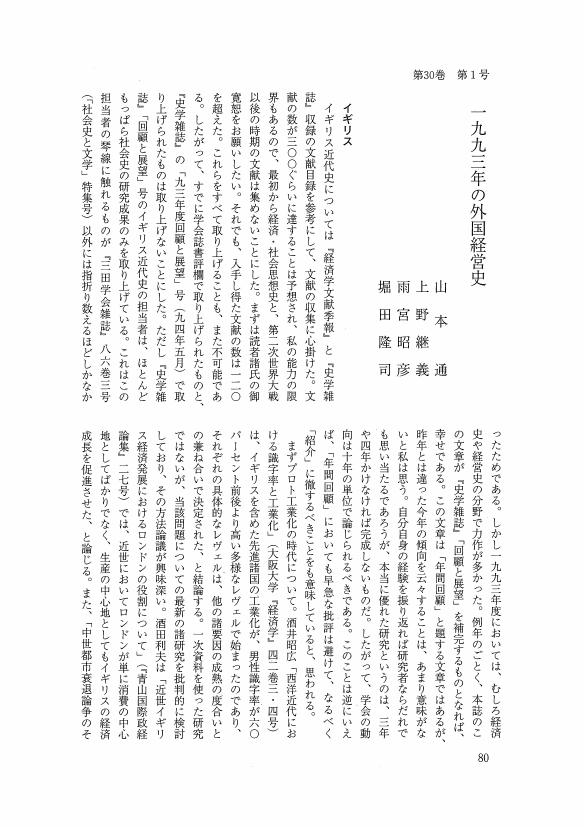- 著者
- 上野 継義
- 出版者
- 京都産業大学
- 雑誌
- 京都産業大学論集. 社会科学系列 (ISSN:02879719)
- 巻号頁・発行日
- vol.31, pp.137-178, 2014-03
2 0 0 0 OA わが国サイクリング史の一断面 : 鳥山新一のサイクリング哲学とその歴史的背景
- 著者
- 上野 継義
- 出版者
- 京都産業大学
- 雑誌
- 京都産業大学論集. 社会科学系列 (ISSN:02879719)
- 巻号頁・発行日
- vol.31, pp.137-178, 2014-03
鳥山新一は、サイクリングの普及に尽力した先覚者の一人である。彼は、財団法人日本サイクリング協会(JCA)のリーダー養成をはじめ、おびただしい量の啓蒙書の公刊や雑誌への投稿、中学・高校向けサイクリング教本の執筆、自転車のマスプロ・メーカーや中小工房へのアドヴァイスなど、さまざまなルートを通じてサイクリングの普及に取り組んだ。彼の働きから今日のサイクリングのすべてがわき出したわけでは勿論ないが、鳥山が日本のサイクリング事情にどのような問題を発見し、それに対していかなる取り組みをしたのかを復元することは、わが国サイクリング史の一面をあぶり出すことになるであろう。本稿はまた、余暇を楽しむ中流階級(近代的消費者)の形成という視点を織り込んで自転車産業の発展を考察するための準備作業でもある。
2 0 0 0 OA 児童労働とサッカーボール : ナイキ社による労働改革の事例
- 著者
- 上野 継義
- 出版者
- 京都産業大学マネジメント研究会
- 雑誌
- 京都マネジメント・レビュー = Kyoto Management Review (ISSN:13475304)
- 巻号頁・発行日
- vol.33, pp.85-101, 2018-10-15
1 0 0 0 OA アメリカ産業における安全運動の波及と労使関係管理の生成 -一九〇八~一九一五年-
- 著者
- 上野 継義
- 出版者
- 経営史学会
- 雑誌
- 経営史学 (ISSN:03869113)
- 巻号頁・発行日
- vol.31, no.4, pp.1-31, 1997-01-30 (Released:2010-11-18)
- 被引用文献数
- 1
The passage of workmen's compensation laws in 1910 and the succeeding years gave a powerful impetus to the efforts of specialists in the area of industrial safety. In this environment the “Safety First” movement, which was an organized effort in accident prevention led by chief safety inspectors who were more commonly known as “safety men, ” extended all over the country. Many safety men were not engineers, so there were some critical views to the movement from engineers who had much training and experience in mechanical engineering and systematic management.At the beginning of the movement safety men and engineers had totally different viewpoints in approaching industrial safety. Engineers insisted that industrial accidents could be prevented by safety devices and in no other way, and that designing the safety devices was an engineering problem. Whereas safety men preached that only a few percent of accident cases could be reduced by guarding dangerous places, and that the prevention of the vast majority of accidents was possible through educational methods eliminating the carelessness of workmen.One of the most important features of the educational programs was the safety committee, which was sometimes composed entirely of foreign speaking workmen for “sowing seeds of caution” among them. The effectiveness of the educational methods was gradually accepted by some engineers, especially members of the Association of Iron and Steel Electrical Engineers. And the Association supported projects of safety men in the steel industry to found a national organization for disseminating the movement. From these efforts the National Council for Industrial Safety was founded in September, 1913 (one year after renamed the National Safety Council).It is interesting to note that in the course of every-day accident prevention work on the shop floor, safety men realized that any safety work would not gain fruitful results without resolving the problems of industrial relations. In order to organize the communication system between employer and employee they enlarged step by step the functions of the safety committee, at last which became in fact the prototype of the employee representation plan. Arthur H. Young, a prominent safety man, recalled that one of the by-products of the safety movement had been the growth of the industrial relations movement.
1 0 0 0 OA 一九九三年の外国経営史
1 0 0 0 OA イリノイ製鋼社における安全委員会活動と雇用管理の近代化 -一九〇七~一九一六年-
- 著者
- 上野 継義
- 出版者
- 経営史学会
- 雑誌
- 経営史学 (ISSN:03869113)
- 巻号頁・発行日
- vol.29, no.1, pp.1-30,140, 1994-04-30 (Released:2009-11-06)
The South Works of the Illinois Steel Company, a U.S. Steel subsidiary, created the safety committee as a main program of the organized effort in accident prevention in 1908. The primary objective of this essay is to describe and document that the company's safety activities on the shop floor level resulted in the labor management reform, and that these activities were led by the chief safety inspectors, more commonly known as “safety men, ” who insisted that the “human factor” was a contributing element in accident occurrence.The safety men faced the same problems that employment managers would have to treat, and shortly realized that no safety devices without improving the employment system seemed to be available to diminish industrial accident rates. In January 1913, the company set up the new managerial position of the Supervisor of Labor and Safety, which integrated both functions of the safety department and the employment department. Arthur H. Young was given charge of this supervisory work. At the same time, the safety men had expanded the scope of the safety committees, so that they organized “combined” committees, a new experiment for improving the relationship between foremen and immigrant workers.From their experience the safety men realized that the safety problem was one of labor management, that no progress in safety could be given without considering the human relationship of employers and employees on the shop floor, and that immigrant workmen were not “backward, crude and ignorant” and could be efficient actors in safety work. Safety men's recognition of this was the most important factor of the successful management reform. In later years, A. H. Young concluded that “one of the by-products of the safety movement” had been the growth of personnel management.
